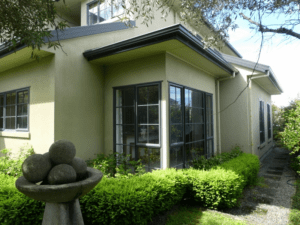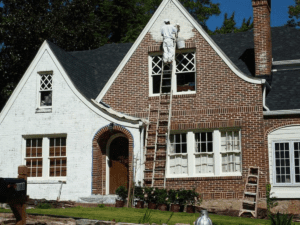
Image Source: Unsplash
As a landlord, one of the concerns you may have is whether you can paint a rental property while it is occupied by tenants. This is a valid question, as you want to ensure that you are following the relevant laws and regulations while also maintaining a good relationship with your tenants. In this article, I will provide an overview of the laws and regulations that pertain to painting a house while it is occupied, as well as best practices for landlord-tenant coordination and communication.
Overview of Relevant Laws and Regulations
Before you consider painting a house while it is occupied, it is important to familiarize yourself with the relevant laws and regulations in your area. Each jurisdiction may have different requirements, so it is essential to do your due diligence. Some common regulations may include notice period requirements, tenant rights, and health and safety measures.
Notice Period Requirements and Compliant Notification Methods
When it comes to painting a rental property while it is occupied, it is crucial to provide proper notice to your tenants. This notice period will vary depending on your jurisdiction, so be sure to check the local regulations. In addition to the notice period, it is also important to use compliant notification methods, such as written notices or electronic communication, to ensure that your tenants are informed about the upcoming painting project.
Tenant’s Right to Refuse and Exemption Cases
While you may have the right to paint the rental property, it is essential to be aware of your tenant’s rights. In some cases, tenants may have the right to refuse the painting project for various reasons, such as health concerns or personal preferences. Additionally, there may be exemption cases where certain tenants, such as those with disabilities or medical conditions, are protected by law and cannot be subjected to the painting process. It is crucial to understand these rights and handle such cases with sensitivity and respect.
Temporary Relocation or Alternative Accommodation for Tenants
In some instances, it may be necessary to temporarily relocate or provide alternative accommodation for your tenants during the painting process. This could be due to health concerns, the extent of the painting project, or the need for uninterrupted access to certain areas of the property. It is important to discuss these options with your tenants and come to a mutually agreeable solution that ensures their comfort and safety.
Environmental Requirements for Painting Materials
When painting a house while it is occupied, it is important to consider the environmental impact of the materials used. Many jurisdictions have regulations regarding the use of environmentally friendly paint and the disposal of paint-related waste. Be sure to choose paints that meet these requirements and properly dispose of any waste generated during the painting process. This will not only help protect the environment but also ensure compliance with local regulations.
Site Management and Protection of Tenant’s Property
During the painting process, it is crucial to manage the site effectively and protect your tenant’s property. This includes taking measures to prevent any damage to the tenant’s belongings, such as covering furniture and flooring, as well as ensuring that the painting crew follows proper protocols to minimize disruptions and maintain a clean working environment. By taking these precautions, you can help alleviate any concerns your tenants may have about potential damage to their personal property.
Health Protection Measures for Tenants
The health and safety of your tenants should be a top priority when conducting any maintenance or improvement projects, including painting. It is essential to ensure that the painting materials used do not pose any health risks, such as emitting harmful fumes or causing allergies. Additionally, proper ventilation should be provided during the painting process to minimize any potential health hazards. Taking these health protection measures will not only comply with regulations but also foster a positive relationship with your tenants.
Noise Pollution Control
Painting a house can be a noisy process, and this can be disruptive to your tenants’ daily lives. It is important to communicate with your tenants about the expected noise levels and make arrangements to minimize disruptions as much as possible. This could include scheduling the painting during non-peak hours or providing noise-cancelling options for your tenants. By addressing noise pollution concerns, you can maintain a harmonious relationship with your tenants during the painting process.
Worker Access Routes and Time Restrictions
To ensure a smooth painting process, it is important to establish worker access routes and time restrictions. Communicate with your tenants about the areas of the property that will be accessed by the painting crew and establish guidelines for their movement within the premises. Additionally, consider any time restrictions that may be in place, such as quiet hours or restricted access to certain areas during specific times of the day. By coordinating these details with your tenants, you can minimize disruptions and maintain a comfortable living environment for everyone involved.
Liability for Tenant’s Rights Compensation
In the event that the painting process causes damage to your tenant’s property or results in any other inconvenience, it is important to understand the liability for tenant’s rights compensation. Depending on the circumstances, you may be responsible for compensating your tenant for any losses or inconveniences they experience. It is important to have a clear understanding of your obligations and communicate them effectively to your tenants to ensure a fair resolution in such cases.
Cost Sharing for Painting Expenses
When it comes to painting a house while it is occupied, the question of who bears the cost of the painting expenses may arise. In some cases, the landlord may cover the entire cost, while in others, a portion of the expenses may be shared with the tenant. It is important to discuss this matter with your tenants and come to a mutually agreeable arrangement. Clearly communicate the financial expectations to avoid any misunderstandings and maintain a positive landlord-tenant relationship.
Best Practices for Landlord-Tenant Coordination and Communication
To ensure a successful painting project while the property is occupied, it is essential to follow best practices for landlord-tenant coordination and communication. This includes providing proper notice, discussing any concerns or preferences your tenants may have, and keeping them informed about the progress of the painting project. By establishing open lines of communication and addressing any issues promptly, you can foster a positive working relationship with your tenants.
Optimal Timing for Painting Projects
Timing is an important consideration when it comes to painting a house while it is occupied. It is crucial to choose a time that is convenient for your tenants, taking into account their schedules and any potential disruptions that may arise from the painting process. By working together with your tenants to determine an optimal time, you can minimize inconveniences and ensure a smoother painting experience for everyone involved.
Other Compromises and Alternative Solutions
In some cases, it may not be feasible or practical to paint a rental property while it is occupied. In such instances, it is important to explore alternative solutions or compromises that can meet both the landlord’s and the tenant’s needs. This could include delaying the painting project until the property is vacant, offering incentives for tenants to temporarily relocate, or finding other creative solutions that maintain the integrity of the property while taking into account the needs and preferences of all parties involved.
In conclusion, while it is possible to paint a house while it is occupied, it is important to navigate the process with care and consideration for both legal requirements and tenant rights. By understanding and adhering to the relevant laws and regulations, effectively communicating with your tenants, and taking necessary precautions throughout the painting process, you can successfully complete the project while maintaining a positive relationship with your tenants. Remember, open communication and mutual respect are key to a successful landlord-tenant partnership.
CTA: If you found this article helpful, be sure to share it with other landlords and property owners who may have similar questions. And if you need any assistance with managing your rental property, feel free to contact us for professional advice and support.



